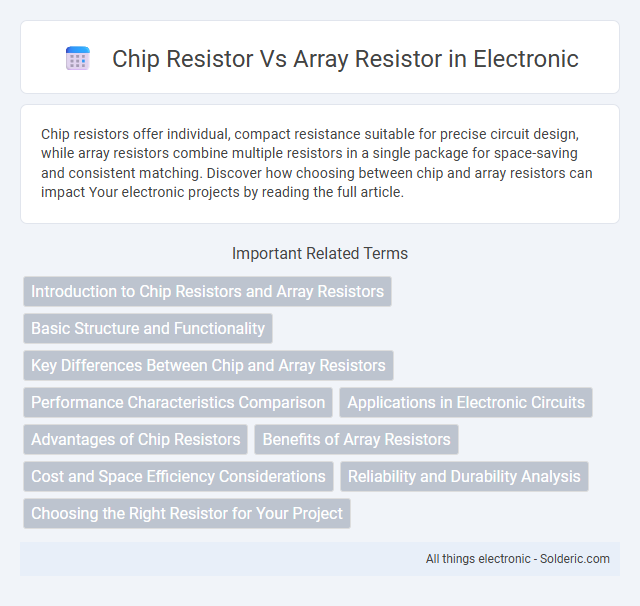Chip resistors offer individual, compact resistance suitable for precise circuit design, while array resistors combine multiple resistors in a single package for space-saving and consistent matching. Discover how choosing between chip and array resistors can impact Your electronic projects by reading the full article.
Comparison Table
| Feature | Chip Resistor | Array Resistor |
|---|---|---|
| Definition | Individual surface-mount resistor component | Multiple resistors combined in a single package |
| Package Size | Varies, commonly 0402, 0603, 0805 | Typical sizes: 1206, 2512 array packages |
| Resistance Range | Wide range from mO to MO values | Usually similar values, designed for matching or networks |
| Applications | General circuit use, fine-tuned resistance needs | Pull-up/pull-down resistor networks, matched resistor sets |
| Space Efficiency | Requires multiple placements for multiple resistors | Combines multiple resistors, saves PCB space |
| Cost | Lower per resistor, higher when multiple needed | Cost-effective for multiple resistors in one package |
| Performance | Individual tolerance and reliability per resistor | Matched resistance values, improved thermal tracking |
Introduction to Chip Resistors and Array Resistors
Chip resistors are single, compact electronic components designed to provide precise resistance values in circuits, widely used for their simplicity and reliability. Array resistors, on the other hand, combine multiple resistors into a single package, offering space-saving advantages and improved circuit organization. Your choice between the two depends on the complexity of the circuit and the need for component density or individual resistor control.
Basic Structure and Functionality
Chip resistors consist of a single resistive element encapsulated in a compact, rectangular ceramic package designed for surface mounting on circuit boards. Array resistors integrate multiple resistive elements within a single package, allowing several resistors to be connected in various configurations to save space and improve circuit reliability. The basic functionality of chip resistors is to provide precise resistance individually, whereas array resistors offer simultaneous resistance in multiple circuit paths with consistent electrical characteristics.
Key Differences Between Chip and Array Resistors
Chip resistors are individual components designed for single resistor applications, offering precise resistance values and compact size, while array resistors consist of multiple resistors integrated into a single package, saving board space and simplifying layout. Array resistors provide matched resistance values and improved thermal stability across resistors, which is ideal for applications requiring consistent performance and reduced assembly time. Choosing between chip and array resistors depends on your circuit complexity, space constraints, and the need for resistance matching.
Performance Characteristics Comparison
Chip resistors offer precise resistance values with low noise levels and high stability, ideal for single-component applications requiring accuracy and minimal tolerance variations. Array resistors integrate multiple resistors in a compact package, enhancing circuit density and consistency, but may exhibit slightly higher parasitic inductance and thermal coupling effects compared to discrete chip resistors. Performance trade-offs between chip and array resistors involve balancing precision, space efficiency, and thermal management in electronic circuit design.
Applications in Electronic Circuits
Chip resistors offer precise resistance values and are commonly used in circuits requiring individual component placement, such as signal conditioning and voltage division. Array resistors integrate multiple resistors in a single package, optimizing space and improving consistency in applications like pull-up/down networks and LED displays. Their compact design suits mass production and complex circuit layouts where uniform resistor values are essential.
Advantages of Chip Resistors
Chip resistors offer high precision and reliability due to their uniform construction and superior thermal stability, making them ideal for applications requiring tight tolerance and minimal noise. Their compact size enables efficient space utilization on printed circuit boards, enhancing design density in modern electronics. Chip resistors also provide excellent performance in high-frequency circuits and withstand harsh environmental conditions better than array resistors.
Benefits of Array Resistors
Array resistors offer significant space-saving advantages by integrating multiple resistors into a single package, reducing PCB footprint and simplifying circuit design. You benefit from improved consistency and matched resistor values, which enhance circuit performance and reliability. Their ease of assembly and lower manufacturing costs contribute to more efficient production processes compared to discrete chip resistors.
Cost and Space Efficiency Considerations
Chip resistors, known for their low cost and compact size, are ideal for simple circuits requiring individual resistors, enabling efficient space utilization on printed circuit boards (PCBs). Array resistors combine multiple resistor elements into a single package, reducing assembly time and overall component count, which translates to cost savings in high-volume production and better space efficiency in densely packed designs. Selecting between chip and array resistors depends on balancing unit cost, PCB real estate, and manufacturing efficiency for the specific application requirements.
Reliability and Durability Analysis
Chip resistors offer high reliability and durability due to their single, discrete construction, which minimizes failure points and ensures consistent performance under thermal and mechanical stress. Array resistors combine multiple resistors into a single package, potentially reducing solder joints and improving circuit compactness, but may introduce risks of cascading failure if one element degrades. Your choice between chip and array resistors should consider specific application requirements, thermal management, and environmental conditions to optimize long-term reliability and durability.
Choosing the Right Resistor for Your Project
Selecting the right resistor for your project depends on factors like space constraints, electrical requirements, and circuit complexity. Chip resistors offer compact design and individual resistance values, making them ideal for simple circuits with limited space. Array resistors combine multiple resistors into a single package, reducing board space and improving assembly efficiency for multi-resistor configurations in complex designs.
Chip resistor vs array resistor Infographic

 solderic.com
solderic.com